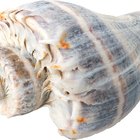
It's an odd fact of the fishmonger's trade that while caviar is some of the most world's expensive seafood, other forms of fish eggs can be remarkably economical. For example, haddock roe is hard to find in stores but is usually sold at a modest price. The sacs of eggs are contained in a tender, edible membrane, so the roes can be cooked or eaten whole. In traditional haddock-fishing areas they're usually pan-fried, or they can be poached for more elegant preparations.
Step 1
Open the package of haddock roes and slide them gently onto a clean paper towel. Pat them dry with another towel, and season them lightly with salt and pepper.
Step 2
Heat a heavy skillet on a medium-high burner. While it's coming up to temperature, dredge the roes carefully in a plate of flour.
Step 3
Pour 1/2 tablespoon of cooking oil or clarified butter into the skillet. Shake any excess flour from the roes, and lay a few at a time into the skillet. Don't crowd the pan, or steam escaping from the roe sacs will prevent them from crisping. It's better to prepare them in batches, if necessary.
Step 4
Turn the roes with a spatula when the first side is golden and crisp, about 2 to 3 minutes depending on their size. Cook for another 2 to 3 minutes on the second side, or until the eggs in the middle of the roe sac have turned yellow and lost their pink tinge. Serve immediately, or keep them warm while you prepare a second batch.
Poached Roe
Step 1
Make a highly-seasoned poaching liquid -- called "court-bouillon" -- by simmering peppercorns, a sprig of thyme, celery, onion or other flavorings in water, with a few grains of coarse salt and a splash each of white wine and white wine vinegar. After 30 minutes, strain the liquid and either cool it to room temperature or refrigerate it until it's needed.
Step 2
Place the roes in a broad, shallow pan and pour in enough court-bouillon to just cover them. Remove the roes, and bring the liquid to a gentle simmer. Its temperature should remain between 160 and 180 degrees Fahrenheit, when tested with an instant-read thermometer.
Step 3
Slide the roes back into the hot liquid, and adjust the burner to keep the poaching liquid within the correct temperature range. Poach the roes for 5 to 6 minutes, or until the eggs inside the sac have turned pale yellow.
Step 4
Drain the roes and serve them warm. Alternatively, puree cooled and peeled roe sacs to make a Mediterranean-style fish-egg pate.
Related Articles

How to Cook Yellow Mullet Roe
How to Cook Fried Flounder Fillets

How to Cook Swai With Breading

How to Cook a Frozen Beef Patty ...

How to Overcook Hard Boiled Eggs

How to Fry Cauliflower Patties

How to Devein Tiger Prawns

How to Preserve a Hard Boiled Egg

How to Fry Mullet

How to Cook Whelks

How to Cook Shrimp in a Skillet

How to Boil Conch in the Shell
How to Freeze Sea Scallops

How to Freeze Romanesco

How to Cook Salmon Fillets on the Stove ...

How to Cook Large Prawns

How to Cook a Sea Robin
How to Cook Seasoned Keta Salmon

How to Cook Fresh Brook Trout

How to Cook Fried Drummettes
References
- On Cooking: A Textbook of Culinary Fundamentals; Sarah Labensky, et al.
Tips
- Pan-fried haddock roes should be treated like a portion of fish, and served with simple accompaniments. Poached roes go well with salads, or can be paired with a wine-based sauce for a more elegant meal.
- Instead of court-bouillon, the roes can be poached in a number of other liquids. One common choice is fish broth with a small amount of lemon juice and white wine added, but they can also be poached in milk, fruit juice or even butter.
Writer Bio
Fred Decker is a trained chef and prolific freelance writer. In previous careers, he sold insurance and mutual funds, and was a longtime retailer. He was educated at Memorial University of Newfoundland and the Northern Alberta Institute of Technology. His articles have appeared on numerous home and garden sites including GoneOutdoors, TheNest and eHow.
Photo Credits
Eising/Photodisc/Getty Images